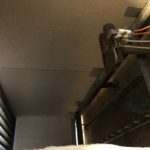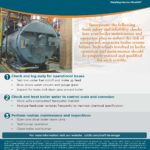
The inspector signs a tag to be affixed to the boiler after inspection.
Steam generation is the heart of many breweries and distilleries, so maintaining the system’s health is vital for safe, efficient and uninterrupted operation.
The inspection process is an important component of preventive maintenance that may help identify issues before a problem occurs.
Nearly all states require boiler inspections, and some insurance companies also perform inspections as part of their underwriting requirements or risk management activities.
PREPARING FOR INSPECTION
When to Inspect
Inspection requirements vary among jurisdictions, but often involve annual inspections by a state licensed boiler inspector. You can find local boiler laws and the authority having jurisdiction at stateboilerlaws.com. Determine when the system was last inspected; usually an inspection tag is affixed to the boiler’s exterior. Schedule an inspection in advance of the system’s certification expiration to avoid disruption. The inspector will inform you if an external or internal inspection will be performed.
Types of Inspection
External inspections are often performed under normal operating conditions with no opening of the boiler, thus no interruption to production. Your steam system operator should be available to discuss operating conditions with the inspector.

Natural gas burner
Internal inspections require additional planning since the system will be offline. Plan production schedules in advance to avoid conflicts and allow for a few hours of downtime. Internal inspections require the boiler be open and out of operation. Who conducts the teardown will vary based on your unique facility, but often it’s done by a contractor or the steam system operator. Prior to inspection, discuss with the inspector what will need to be open for them to view or observe.
Based on system design, areas that will need to be open could include cross-connecting pipes, plugs, caps, floats, probes and burners as well as other systems.
WHAT TO EXPECT
Time and Documentation
Whether internal or external inspection, make available your water chemistry logs, blowdown and maintenance records. The inspector may review them with your operator when discussing operating conditions and asking about the system’s service history.

Firing tube (internal view)
An external inspection may last 15 to 30 minutes, while an internal inspection may require 30 to 45 minutes in addition to an hour for teardown and an hour for rebuild.
External Inspection Items
Inspectors generally look at the boiler’s exterior paint for discoloration, a sign of potential overheating, and will use a sight glass to look for clean combustion. Piping, joints and relief valves will be visually inspected for leaks or other signs of weeping. On high-pressure systems, the low-water cutoff may be tested where possible.
Internal Inspection Items
With the boiler torn down, inspectors will take a closer look at internal components.
Firing tubes above and below the water line are visually inspected for signs of oxygen pitting and corrosion. Changes in the surface of the firing tube, such as blisters or signs of rust, may indicate a potential water chemistry issue. If left unresolved, damage to the firing tube and other internal components may result.
Water level probes and float valves should appear clean and free of buildup. Dirty probes or buildup on float valves are a quick indication of a more serious issue within the system. A failed water shutoff could result in damage to the system caused by dry-firing.

Combustion chamber refractory panels
Burners are visually inspected for signs of combustion issues, commonly in the form of soot buildup. Soot is the result of inefficient combustion and, left unchecked, diminishes burner efficiency and longevity. Common combustion issues include incorrect burner air/fuel mixture tuning, lack of make-up air from inadequate room ventilation or improper damper size or installation.
Combustion chamber refractory panels are inspected for large cracks or crumbing material that may contribute to system overheating. Boiler exterior paints are typically designed to show signs of overheating through discoloring or by turning a lighter shade.
POST INSPECTION ACTIONS
A new inspection tag with date and inspector signature will be affixed to the boiler exterior. Follow up with the inspector on any violations or recommendations that have been resolved so they can notify the authority having jurisdiction to file an inspection report, and the certificate can be issued.

Maintenance Considerations for Steam Boilers – Click for larger image, or download PDF version below.
Check with your insurance carrier or state inspector to determine if you are responsible for notifying the authority and requesting the certification. If you are a policyholder of The Cincinnati Insurance Company and one of our state-licensed inspectors completes your inspection, this notification will be completed on your behalf.
This loss control information is advisory only. The author assumes no responsibility for management or control of loss control activities. Not all exposures are identified in this article. Contact your local, independent insurance agent for coverage advice and policy service.
Maintenance Considerations for Steam Boilers (PDF 322K)
